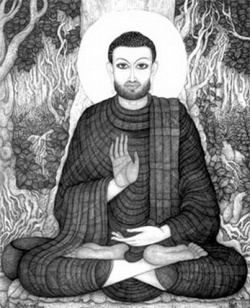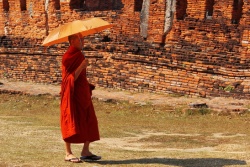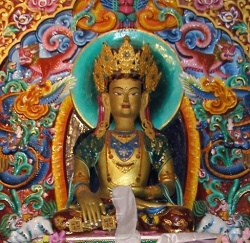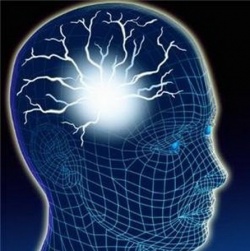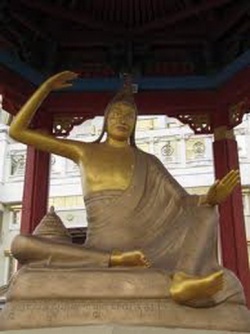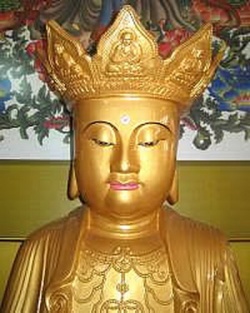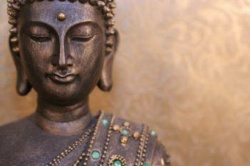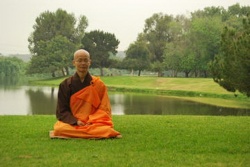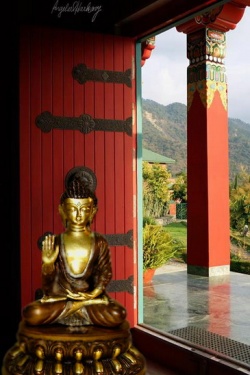Buddhist Sutras
The Theravada branch of Buddhism uses Pali as its sacred tongue.
In Pali, the word for scripture is sutta. The Mahayana uses Sanskrit, and there the pronunciation is sutra. These words are often translated as Discourse in English (lecture is not appropriate here, as no reading was involved, and sermon has a connotation of admonition or scolding.) Besides the two Indian classical languages, Chinese and Tibetan also played important roles in the preservation of the Buddhist canon.
The Buddha enjoined his disciples to separate and go to different places and teach in the local languages, so right from the beginning there arose various versions and translations of his discourses. He also told his listeners and students to question and to test his teachings like a jeweller would test yellow metal.
There are three main traditions as to what constitutes the canon, or the body of Buddhist scripture: the Theravada, the Chinese and the Tibetan. [Link is to an appendix to The Buddhist Religion, 4th ed.] They all contain words of the Buddha and those of his students.
The Various Editions
The Tibetan canon of essential Buddhist scripture consists of two parts called the Kangyur (or Kanjur, sp. bKángjur) ie, "Translation of the Buddha's Word" or the sutras, and the Tangyur (sp. bStan-'gyur) that is, "Translations of Teachings" -- traditional commentaries.
There are a number of popular Tibetan editions; each is designated by place of publication as the Co-ne, the Derge sDe-dge and the Narthang editions.
The completed printing of the Kanjur occurred first in Beijing, China in 1411. The first Tibetan edition of the canon was completed at Narthang (sp. sNar-tang) in 1742. It has a Kanjur of 98 volumes (101 in the Lokesh Chandra 2000 edition):
1. Vinaya: 13 vol.
2. Prajnaparamita: 21 v.
3. Avatamsaka: 6 v.
4. Ratnakuta: 6 v.
5. Sutra: 30 v. (270 texts, Hinayana comprising about 25%)
6. Tantra: 22 v. (more than 300 texts)
The Narthang Tanjur (226 volumes in the Lokesh Chandra edition) contains over 3, 600 texts that include collections of stories, commentaries on tantras and sutras, along with discussions on vinaya and abhidharma including Prajñaparamita, Madhyamaka, Yogacara and Vijnanavada texts. It also contains works on logic, rhetoric, grammar, literature, biographies, painting, medicine and chemistry, astrology and divination.
The Asian Classics Input Project (ACIP) has portions of Kagyur and Tengyur available online in transliterated Tibetan and also in Tibetan script (Sambhota font required.)
The Bonpos also have a version of Kangyur-and-Tanjur, and the various Tibetan Buddhist denominations each consider their version to be the essential one. This is only to be expected since each school includes the foundational teachings of, and the elucidations by, their own realized masters. For example, Nyingmapas emphasize the teachings of Padmasambhava. But even the Sarma or "New Translations" schools present differences in the contents of the Canon.
Kagyu Essential Texts
"In particular, for the Karma Kamtsang there are three main texts that form the course of study for aspiring meditators and yogis. First, the Uttaratantra Shastra, otherwise known as the Ratnagotravibhaga. This has been published as "The Changeless Nature," and also, with commentary, as "Buddha Nature," most recently. Second is the Hevajra Tantra. A translation of this has been made in English, by Snellgrove. Third, the Zabmo Nangdon, or "Profound Inner Meaning," which to my knowledge has not been translated, and which deals with Highest Yoga Tantra theory and practice in exhaustive detail, from what I have heard. This text, along with the Hevajra Tantra, can really only be studied by receiving the transmission and explanation from a qualified teacher. Actually, traditionally, all these texts would only be studied in that manner.
A "Khenpo in Training" would be intimately familiar with these three, as well as with many other texts from the Kangyur and Tengyur, and with many, many texts not included in these two collections, including commentaries on canonical texts, texts dealing with logic, abhidharma, monastic vows and conduct (vinaya), meditation manuals Ngedon Gyamtso "The Ocean of Certainty (or "of Definitive Meaning") sadhanas and explanations of the practices of the yidam deities, protectors, etc.
Very few masters would be familiar with the entire corpus of the Kangyur and Tengyur. It's huge.
To understand the Karma Kamtsang view, I'd recommend reading Shantideva's Bodhisattvacharyavatara, in any one of a number of translations. Gampopa's Jewel Ornament, again with numerous translations, Buddha Nature by Maitreya /Jamgon Kongtul/ Khenpo Tsultrim Gyamtso, and Takpo Tashi Namgyal's Mahamudra. The Ocean of Definitive Meaning is also a key which you should seek out the transmission for, and study with a qualified teacher."
Uttaratantra Shastra (Ratnagotravibhaga) S. Hookham's The Buddha Within, 1991.
also, Buddha Nature: The Uttaratantra Shastra. Maitreya, Jamgon Kongtrul, Kh. Tsultrim.
Hevajra Tantra Concealed Essence by Farrow.
Profound Inner Meaning in 2 texts, restricted to those who have had the transmission.
The Ocean of Certainty (Ocean of Definitive Meaning) commentary by Thrangu Rinpoche.
Shantideva's Bodhisattvacharyavatara transl. by the Wallaces.
Gampopa's Jewel Ornament of Liberation. With commentary by Thrangu Rinpoche.
Tashi Namgyal's Mahamudra (2006 edition.)
What's in Famous Scriptures
To the Kalamas (AK 65)
" . . . do not be led by reports, or tradition, or hearsay. . . . by the authority of religious texts, nor by mere logic or inference, nor by considering appearances, nor by the delight in speculative opinions, nor by seeming possibilities, nor by the idea "this is our teacher".
. . . when you know for yourselves that certain things are unwholesome (akusala) and wrong and bad, then give them up . . . . And when you know for yourselves that certain things are wholesome and good, then accept them and follow them."
Like Gold
From an unnamed sutra quoted in two Madhyamaka texts:
Jnana-samuccaya (31) quoted by Aryadeva ( 3rd-century CE). Available in Tibetan and Sanskrit.
Tattva-samgraha by Shantarakshita (8th-century.) Avail. Tibetan and Chinese.
"As the wise test gold by burning, cutting and rubbing it, So, bhikshus, should you accept my words -- after testing them, and not merely out of respect."
In Malayasian Pali, "Taapaac chedaac ca nikasat svarnam iva panditaih; Pariiksya bhiksavo graahyam madvaco na tu gauravaat."
Dr. Alexander Berzin, in Relating to a Spiritual Teacher (Ithaca: Snow Lion, 2000) attributes this verse to "The Sutra on (Pure Realms) Spread Out in a Dense Array."
Lankavatara Sutra expounds on:
1. The Doctrine of Mind-Only
2. The Concept of No-Birth
3. The Triple Body of the Buddha
4. The Tathagata
Mahapadana Sutta: Greater Discourse on the Lineage
Besides telling us that there were buddhas from time immemorial such as:
". . . Buddha Vipassi arose in the world. Thirty-one aeons ago the Lord Buddha Sikkhi arose; in the same thirty-first aeon . . . Vessabhu arose. And in this present fortunate aeon the Lords Buddhas Kakusandha, Konagamana and Kassapa arose in the world. And, monks, in this present fortunate aeon I too have now arisen in the world as a fully-enlightened Buddha".
Here we get the account of their self-discovery:
"And as he was being driven to the pleasure-park, Prince Vipassi saw a shaven-headed man, one who had gone forth, wearing a yellow robe. And he said to the charioteer: ‘What is the matter with that man? His head is not like other men’s, and his clothes are not like other men’s."
Maha-Saccaka Sutta (Majjhima Nikaya 36) To Saccakka
The Buddha tells in detail the steps he took on his way to his achievement. It describes his early yoga practice and what went through his mind. Until, in the third watch of the night:
"Ignorance was destroyed; knowledge arose; darkness was destroyed; light arose -- as happens in one who is heedful, ardent, & resolute. But the pleasant feeling that arose in this way did not invade my mind or remain."
Mahaparinibbana Sutta: The Buddha’s Dying Days
We see from the translation that it is not clear what the cause of death was. Also, if the expression pig’s delight is an accurate translation, the meal does not refer to pork; truffles, maybe?
"Then the Lord said to Cunda: ‘Whatever is left over of the "pig’s delight" you should bury in a pit because Cunda, I can see none in this world with its devas, maras and Brahmas, in this generation with its ascetics and Brahmins its princes and people who if they were to eat it could thoroughly digest it except the Tathagata."
Aggañña Sutta: Knowledge of Beginnings contains Buddhist cosmogony. There is the description of the eons and ages, how the inhabitants of worlds grow or shrink in size and their life spans change as well as their primary concerns.
". . . sooner or later after a long period, this world contracts. At a time of contraction beings are mostly born in the Abhassara Brahma world. And there they dwell, mind-made, feeding on delight, self-luminous, moving through the air, glorious – and they stay that like that for a very long time. But sooner or later after a very long period, this world begins to expand again."
Digha Nikaya or The Longer Discourses, pre-100 BCE.
In the Kevatta Sutta or, Kevaddha Sutra (DN 11) learning, understanding and applying the Dharma is said by Buddha to be superior to the attainment of any siddhi or magical power. Here, the householder Kevatta suggests that more people would join up if the Master would cause his monks to perform miracles.
Buddha Shakyamuni replies that there are 3 skills that he, himself, has perfected:
magical power
telepathy
instruction in Dharma
1. Magical power is the ability, before an audience, to multiply one's form and then become just one again, or to travel to the various realms and then to return.
The thing is, says the Buddha, people tend to say to a witness of this sort of thing, that the miraculous abilities are due to "the Gandharan [Hellenic-Persian, ie. Greek] charm." (We might say, "It's a Secret of the Mysterious East", or an example of the powers of "Himalayan Masters.")
2. If some monk were to demonstrate the ability to read the minds of others, again some sceptic would disparage this ability, too, saying "Anyone who has the Manika charm can do the same."
3. But through the miracle of instruction, the monk says what to do, how to do it and explains the result that will be obtained. And anyone who follows the method will get the same beneficial result.
In other words, if you follow the instruction, you get the result. It is tried and true, and it works for anyone.
That, said the Buddha, is a true miracle!
The sutra goes on however, after listing all the types of fortune-telling or prognostication that it is not suitable for a follower to do, to speak of abilities that can be achieved by those who discipline themselves according to the Buddha's instruction. Having learned mindfulness and non-attachment, the person can go on to the four jnanas [Skt: dhyanas or wisdoms -- stages of meditative accomplishment that begin in bliss and culminate with insight into the nature of mind.
Then, the practitioner having attained imperturbability and the cessation of "fermentation" in which thoughts breed more thoughts that breed consequences, and so on -- then he or she can see, fly, or appear and disappear, view past lives, perceive the thoughts of others, achieve the mind-created body and, understanding that even the elements have no inherent existence, can converse with beings of other realms. And this is achieved through the only miracle performed by a Buddha -- the miracle of instruction!
Lohicca Sutta: (DN 12)
The wealthy upper-caste man Lohicca asks, given karma and all, "What's the use?"
"Just then this evil line of reasoning occurred to Lohicca, "Suppose an ascetic or Brahmin were to discover some good doctrine, having done so, he ought not to declare it to anyone else; for what can one man do for another? It is just as if a man, having cut through an old fetter, were to make a new one. I declare that such a thing is an evil deed rooted in attachment, for what can one man do for another?"
Mahanidana Sutta (DN 15) Great Causes
This discourse focuses on the workings of aspects of existence that keep us bound to the system of sequential existence. That is, the aspects as they are depicted in the diagram of the Wheel of Rebirth: birth, becoming, clinging, aging and death, "name-and-form", and so on.
It also includes the seven stages of beings according to their] consciousness and the two spheres: those that are non-percipient and those that neither perceive nor not-perceive, so that one may speak of eight emancipations in someone who is truly free.
MahaSatipatthana Sutta (DN 22) Maha or long version has the 4 Noble Truths.
Here the Buddha speaks of contemplation using four frames of reference: Body, Feelings, Mind meditation and the "mental qualities" or attitudes.
It ends somewhat humorously as the Master says that if you practice in that way you can achieve enlightenment or at least, release from samsara, in 7 years -- or six -- or even five, and so on down to a couple of weeks.
MahaSamaya Sutra (DN 20) The Great Gathering
It consists mainly of an ancient hymn in which all the beings of the upper realms gather in the Buddha's presence. All the devas including Indra and Shiva, mentioned by their epithets -- titles or/and 'nicknames' -- along with the nagas, garudas, and even Mara and his "dark army" (though they do not stay,) meet in a state of suspension of conflict in order to do honour to the One who can teach the way out of samsara.
Samaññapala Sutta (DN 2) Fruits of the Contemplative Life
King Ajatasatru (Pali: Ajatasattu) was the sponsor of the First Buddhist Council. He was the son of King Bimbisara of Magadha (Bengal) Buddha Shakyamuni's patron, but he was also an ally of Devatta, the Buddha's murderous rival. He decides to go and see the Buddha to ask some questions. The Buddha explains to him patiently all the details and benefits of practicing his teachings.
In a dramatic and even touching description of the King's setting out to visit the Teacher whose camp near the capital Rajgriha is so quiet, we learn of the ruler's anxiety. He even fears there is an ambush.
The Buddha gently begins by reminding Ajatasatru that he had asked questions about the teachings before and on several occasions, and in his skilful way he asks him to tell what he had heard before.
Sigalovada Sutta (DN31): When the Teacher is asked by Sigala how an ordinary person ought to behave, the Buddha responds by reviewing the 5 layperson's vows and then enlarges upon them by referring to the temptations present in city life. The person will succeed by using the points of the compass as a guide: The parents should be looked upon as the East, teachers as the South, wife and children as the West, friends and associates as the North, servants and employees as the Nadir [down,] and the ascetics and brahmins as the Zenith [up.]
The Heart Sutra is a short version of the Prajnaparamita Sutra.
Shuranagama Sutra: A fundamental Mahayana scripture for those working on the nature of the mind, it tells how Ananda searches for Mind's location in 7 places. [Ron Epstein's explanation. ]
Vajracchideka Sutra ("The Diamond-cutter") : The world's oldest extant printed book
All conditioned dharmas
Are like dreams, illusions, bubbles, or shadows;
Like drops of dew, or flashes of lightning;
Thusly should they be contemplated.
Vimalakirti Nirdesa Sutra: When the Buddha is asked why Amitabha inhabits a beautiful Pureland, but he (Shakyamuni) has only this poor, miserable, ordinary world, the Buddha puts his toe to the ground. Then the disciples see the whole world transformed with splendid jewels, sparkling lights of all colours, and the melodious hum of mantras. He exclaims: "This is how I see the world!"
Then he lifts his toe, and we are back to what we call mundane reality. The Master explains: "The ordinary world that you see is due to your habitual mental obscurations!"
______________________________________________________________
Pali: The word “Pali” originally designated the scriptures themselves. The language spoken by the Buddha, which was a dialect similar to Sanskrit, ought to be called "Maghadhi."
Akusala: a play on the name of the Indian province, Kosala, which was home to the Kalama family

